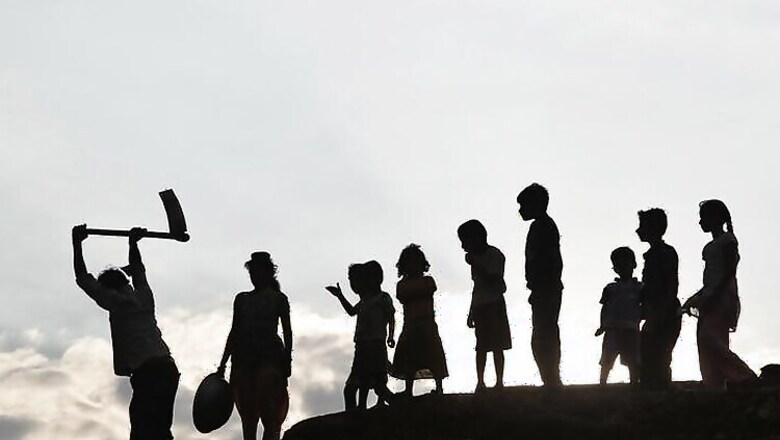
views
Ponneri: When police raided the brick kiln in southern India where Siriya Banchor had been conned into a life of bonded labour - along with hundreds of other poor, illiterate migrants - the 48-year-old seemed more bewildered than relieved.
Fumbling in the darkness of a windowless mud-and-brick room she had shared with her family for more than two months, Banchor stuffed her things into a sack, took her child's hand and emerged into the bright glare of the afternoon sun.
"I have two sets of clothes, two utensils and a little rice. We came with nothing, hoping to earn enough to pay back our loan," she said, stepping over piles of half-baked bricks to join other rescued workers waiting to board trucks that would take them to temporary lodgings.
"We are going back with nothing but at least the suffering will end," Banchor said as she stood amid the crowds at the kiln on the outskirts of Chennai.
In all, 564 brick kiln workers, including Banchor, were rescued last week by police and local authorities acting on a tip-off from an employee at the kiln. It was one of the largest such operations in India - shedding light on the huge number of labourers trafficked into servicing the country's booming construction industry, activists say.
"The scale and magnitude of the problem is massive," said Chandan Kumar, founder of "Blood Bricks" - a campaign launched two years ago to expose abuses in the construction sector.
"There are gross violations happening in many of these kilns, but the government does not have the resources or the capacity to inspect these places and check on the conditions under which workers are living, much of which amounts to modern day slavery."
BUILDING CITIES FROM BONDED LABOUR
India is home to almost half the world's 36 million slaves, according to the 2015 Global Slavery Index, produced by the Australia-based Walk Free Foundation.
Many Indians are duped into offering themselves for work in farms, brothels, small shops and restaurants as security against a loan they have taken or a debt inherited from a relative.
This kind of exploitation is especially common in the construction sector, particularly in the unregulated areas of brickmaking and stone quarrying, experts say.
Yet construction is one of the most important sectors in the Indian economy, providing around 35 million jobs and contributing eight percent of the country's GDP.
With India's towns and cities projected to swell by an additional 404 million people by 2050, demand for infrastructure and services will continue to be voracious.
The government admits current levels of infrastructure are inadequate. In the urban housing sector alone, there is a shortage of 18.8 million "dwelling units", it says.
"There is definitely a link between the building you see coming up in the city and the pile of bricks lying outside the construction site which come from brick kilns employing bonded labour," said PM Nair, a leading expert on human trafficking and modern day slavery.
"When a contract is awarded, it includes labour cost but not even one percent is put aside for their welfare," said Nair, who is chair professor and research coordinator on human trafficking at the Tata Institute of Social Sciences in Mumbai.
TRAFFICKED AND DUPED
There are no official figures on the number of people employed to cut, shape and bake clay-fired bricks mostly by hand in India's tens of thousands of brick kilns.
According to a 2015 paper by the Centre for Science and Environment at least 10 million people work in kilns, many located on the edge of towns and cities making them easily accessible for urban builders.
In Ponneri, about 50 km (30 miles) from the coastal city Chennai, the capital of Tamil Nadu state, rescued workers at the Sri Lakshmi Ganapathi Brick Industries brick kiln described how they were brought here two months ago by agents.
The workers, all from the eastern Indian state of Odisha, said traffickers visited their villages, offering loans of 20,000 rupees ($300) in exchange for six months labour.
The trafficker then sold the debt to another "agent" who brought them in batches by train to Chennai.
"The agents who come to our villages spot the families in distress. They know when there has been an unforeseen expenditure and then offer the loans," said one worker, a young, bare-chested man who followed his uncle to the kiln.
"They come to us when we have hit rock bottom and have no choice but to agree to their terms."
UNCERTAIN FUTURE
The labourers, along with their children, said they worked 10 hours daily, slept in tiny rooms with their familes, and had no access to clean water or toilets.
They were told they would be expected to work from January to June, before the monsoons usually strike, disrupting work.
Each family, some of them with elderly or pregnant women, was expected to produce at least 2,000 bricks daily. If they did not, less money would be deducted from their loan.
They said they received no official documentation of the loan and did not know how much of the debt they had cleared.
"Each family has a debt of up to 20,000 rupees($300). And they are being paid only 400 rupees ($6) per family every week, without being allowed to go home unless they paid the entire amount," said M Narayanan, revenue department official leading the raid.
A doctor working for the brick kiln owners, who was arrested along with five others, including site supervisors, told the Thomson Reuters Foundation he provided a steady supply of painkillers to ensure workers kept working.
A disregard for labour laws, impunity for agents and brick kiln owners and few alternatives for workers who are rescued made it difficult to break the cycle of exploitation, campaigners said.
"In most cases, the rescued labourers say they had no means to get the next meal and therefore no choice but to go with the agent," said Mathew Joji, a spokesman for International Justice Mission, a US-based human rights group.
"Unless that ground reality changes, things will not improve for them even after rescue."
R Geeta of the Unorganised Workers Federation said rescue was often not the end of debt bondage. "With no monitoring, many of those rescued will get into second bondage or work for another employer in equally bad conditions," Geeta said.
For Banchor, there is little guarantee of a better life once she and her family return to their village.
"We are going home but our future is uncertain," she said as she jostled to board the bus out of the brick kiln.



















Comments
0 comment